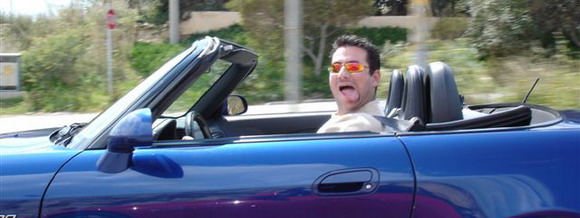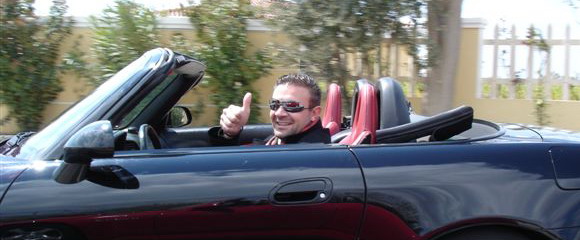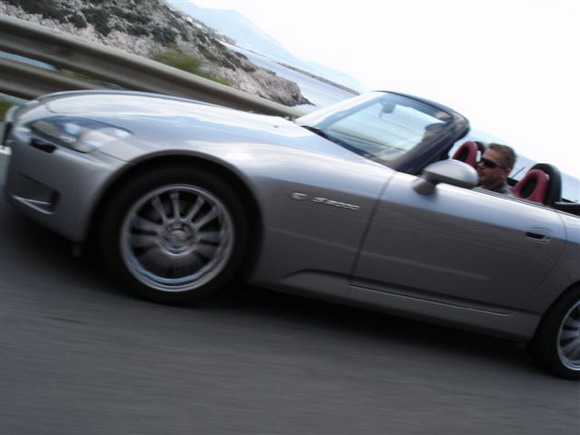What is a good choice for sunglasses?
 Sunglasses. Of all the things that become important when driving a convertible, sunglasses are arguably the most important thing to have. With the top down on a nice sunny day, or even an overcast one, being able to see where you’re going is greatly enhanced by a quality pair of specs, but how much do you really know about sunglasses? Is there something that might work better for a convertible vs other situations? No matter the time of year, it will always be sunny and you’ll always need sunglasses.
Sunglasses. Of all the things that become important when driving a convertible, sunglasses are arguably the most important thing to have. With the top down on a nice sunny day, or even an overcast one, being able to see where you’re going is greatly enhanced by a quality pair of specs, but how much do you really know about sunglasses? Is there something that might work better for a convertible vs other situations? No matter the time of year, it will always be sunny and you’ll always need sunglasses.
First, a background on glasses. They basically come with glass or plastic lenses, those lenses come in a two main colors, and there are specific lens treatments that can enhance their performance to our benefit. For glass vs plastic, glass is heavier, but is denser and less prone to scratching. Its also easier to see through (whether you can tell the difference or not), causing less eye fatigue, but it is harder to fit into a wrap sunglass without distorting vision.
Lens colors fall into two basic varieties – grey and amber/red, with green predominant in some Ray Bans. Sunglass lenses aren’t blue because blue is the predominate color of distortion – it has the shortest wavelength so it bends, or refracts, the easiest, causing haze and blurry vision.
Grey is best for bright sunny conditions, like being at the beach or at sea, where you really just need to tone down the brightness. In dimmer lighting and at dusk/dawn when the sun is low and shadows predominate, grey lenses can become too dark to wear however.
Green lenses function a lot like grey lenses but offer a bit more contrast for lower-light conditions.
Amber lenses excel at these times as they do not darken your vision too much and allow you to better see in dimmer conditions and on overcast days, but some people find them too bright on a nice sunny day. To combat this, one brand, Serengeti, makes photochromic lenses that actually get darker when exposed to sunlight so they can vary according to brightness conditions.
Red lenses are a step darker and enhance contrast while providing more bright-day coverage. For driving in general, an amber or red lens is going to aid you across most of the conditions you will face, but there really s no one lens that does it all.
Beyond construction material and color, sunglasses can also have coatings applied to the lens. The two most important are a polarizer and an anti-reflective coating (typically blue) on the inside, to keep glare out of your eyes.
Without getting into a whole history lesson, you should know that there are a few basic types of glass frames, and a host of variations on those themes. The biggest split is between a traditional squared frame or “wrap” – rounded frames that adhere more closely to your head. Best way to visualize this is with the classic Ray Ban Wayfarer vs an Oakley… any Oakley, really.
 Driving a convertible, having a wrap sunglass will serve you better for protecting your eyes and enhancing your vision. Generally associated with activity and sports, wrap designs excel at keeping the frame out of your field of vision and at keeping the lenses close enough to your head to keep out wind, light pollution, and foreign objects.
Driving a convertible, having a wrap sunglass will serve you better for protecting your eyes and enhancing your vision. Generally associated with activity and sports, wrap designs excel at keeping the frame out of your field of vision and at keeping the lenses close enough to your head to keep out wind, light pollution, and foreign objects.
Wind will dry out your eyes and cause fatigue. Light pollution is that sunlight that comes in behind the sunglass lenses and either hits you right in the eye or bounces off the inside of a lens, causing glare. With no top or side windows to shield you, its possible to get dinged by something coming off the road, like a small rock, or even a burrito. Being top down in the car, you are exposed to all of this, and want to keep it all out of your eyes, so a wrap style frame will best protect you.
So now you have some background on sunglasses and why they are made the way they are, whats a good choice for some sunglasses? Won’t just any pair of cheap glasses do? The answer to that is yes and no – even your local gas station cheapies are better than nothing when it comes to getting hit by something, but with better glasses comes better performance. Cheap glasses typically have wavy lenses with uneven densities that make it harder for your eyes to focus, wearing them out, which causes eye strain and can give you a headache.
Better lens construction and special coatings will fatigue your eyes less, and quality frames will be adjustable to feel good and won’t fall apart. Plus, you care about performance right? That’s why you’re driving an S2000 and not a Geo Metro convertible.
 So what are the quality brands you should look at? Quality sunglasses come in tiers based on the technology and performance they offer, but in general the best brands are Maui Jim, Serengeti, Costa Del Mar, Revo, and Ray Ban for glass; Maui Jim, Oakley, Bolle, for plastic. Its ultimately up to you to check out these brands and find the best pair of sunglasses for yourself, but now maybe you know a bit more about what to look for.
So what are the quality brands you should look at? Quality sunglasses come in tiers based on the technology and performance they offer, but in general the best brands are Maui Jim, Serengeti, Costa Del Mar, Revo, and Ray Ban for glass; Maui Jim, Oakley, Bolle, for plastic. Its ultimately up to you to check out these brands and find the best pair of sunglasses for yourself, but now maybe you know a bit more about what to look for.
So what sunglasses do you use? Any brand or model you swear by? Is there a particular sunglass that just fits the style of the S2000?
Photos courtesy of VAG
